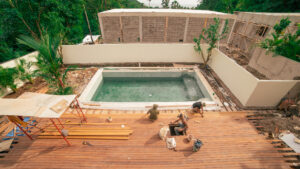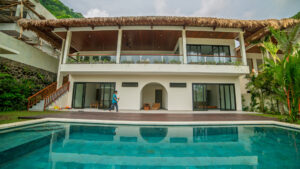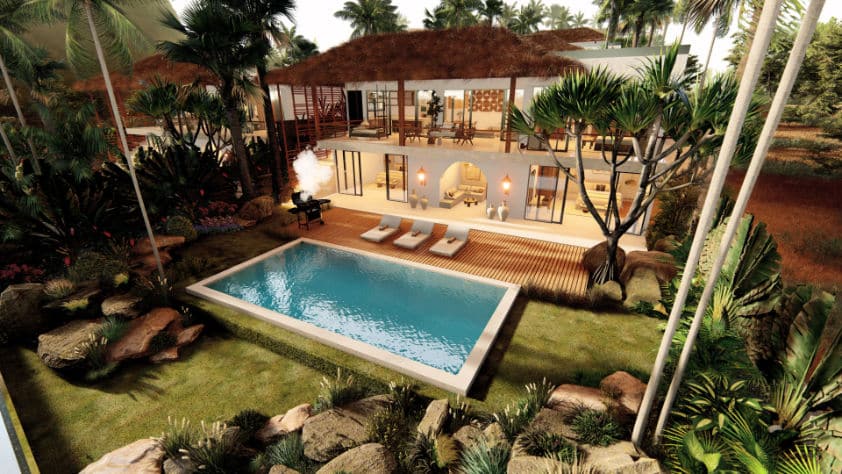Is a Bali villa investment a good idea?
Bali villa investment has proven to be an investor’s dream over the past two decades.
Tourist numbers have increased and the trend for holiday villa rentals has exploded. As a result, property development has surged to meet the rising demand.
The influx of foreign investment has created a resilient market for property sales and holiday villa rentals in the more developed tourist resorts of Seminyak, Sanur, Canggu and Ubud.
Whilst early property investors in these areas have made life changing returns on their investments, this article will use the 18 Year Property Cycle to suggest that the real estate markets in Bali’s developed tourists areas have become saturated.
Moreover, the 18 year property cycle when applied to Bali, suggests that growth cycle in these tourist hotspots is less than 2 years away from its peak.
Continue reading to learn....
- How Bali’s real estate market is performing in 2024;
- Which areas of Bali are close to their cycle peak;
- Which areas have the highest growth potential;
- How to profit from a Bali villa investment.
Investing in a Bali villa
The Southern part of Bali has been exposed to major levels of development as places like Sanur, Canggu and Seminyak have emerged from being sleepy towns into large scale tourist destinations.
The results for property investors have been financially outstanding. Early buyers of real estate have seen a return on the price of a property upwards of 500% in less than a decade.
The returns on investment become even more impressive when we consider that the rental income from a holiday villa can account for significant returns with an investment payback rate between 5-7 years.
High-yield rental returns have been generated through the demand created by increasing tourists numbers and longer-term expat residents.
In-turn, rental occupancy rates are sustained at high levels upwards of 70% year round.
The price of property in the most developed areas of Bali have risen exponentially. So whilst the principal investment capital used to buy a property has been paid back with rental profits, villa owners are also sitting on substantial equity gains in the underlying values of their properties.


Bali property markets in 2024
Whilst the influx of tourists to Bali has resulted in impressive returns for landowners, property owners and businesses serving the boom towns, there are a number of negatives that are creating a shift in investor perception.
- The price of land and property is simply too high for many new investors to enter the market.
- As most areas are flooded with an oversupply of property, sale and rental profits are being squeezed in what is termed a ‘buyers market’.
- A ‘buyers market’ essentially means that since buyers have so much choice, sellers are having to cut their prices and in turn, cut their profits.
- Part of Bali’s charm is the intricate road network that weaves through villages, hills, rice paddies and coastline clifftops. The overdevelopment of the Southern areas has created chaos on the roads.
- Traffic jams and congestion are everywhere, with short journeys to the grocery store taking upwards of an hour each way.
- The basic cost of living is becoming expensive. Rental prices for convenience stores and restaurants have risen in line with villa rental costs.
- Business owners have been forced to raise their prices to cover these costs. The end consumer is the one who pays for the cost of inflation.
There comes a point in every growth cycle where the pace of growth begins to slow before rapidly stagnating.
Consumers can not continue to fuel price increases as the balance of value tips over and beyond what the consumer is willing to pay.
This applies to the cost of rent, a bag of apples and even for wasted time sitting in traffic.
The 18 year property cycle
The 18 year property cycle is an investment model that property investors use to identify the ups and downs of a property market in a relatively predictable pattern.
Based on long-term historical data of global real estate markets, the property cycle model provides an estimate that runs through four distinct phases that take on average 18 years to play out.
As an average, some cycles will take longer to complete, other cycles will complete in less that the 18 year average.
Whilst the model refers to a ‘property’ cycle, the concept is essentially based on a ‘land’ cycle. The cost of building a house in Bali is much the same in Canggu as it is in Amed.
The big difference in the price of a property is simply due to the underlying price of the land that the property occupies.

Phases of the property cycle
Understanding the phases of the property will give you the best possible chance of timing the market so you can optimise your Bali villa investment.
The goal for any real estate investor is to buy low, maximise rental profits, before selling around the market peak.
- Property prices have bottomed at the end of the previous cycle
- Rental yields are up as rental prices do not fall at the same rate as property prices
- Savvy investors recognise the market opportunity and begin to acquire property at attractive valuations
- Amateur investors are unable to recognise that their upside potential far outweighs their downside risk
Around 7 years into the cycle, following a period of price growth during the Recovery Phase, some early investors are happy to exit the market and bank their profits.
The sell-off period is typically short but it allows for a fresh wave of market participants to take advantage of slightly corrected prices.
The Mid-cycle Correction is seen as an opportunity for those who were late to buy during the Recovery Phase. To avoid missing out on valuation gains, or perhaps to buy whilst valuations are still affordable, the new participants are quick to act resulting in a rapid increase in buyer demand.
With the increased demand fuelled by new participants capitalising on the Mid-cycle Correction, property prices begin to rise leading to confidence within the sector.
Property owners look to move up the ladder, amateur property investors re-mortgage their portfolios to acquire more property in fear of missing out, and first time buyers take advantage of favourable mortgage offers from banks more confident and willing to lend.
The situation evolves as demand pushes prices ever higher. During this Explosive Phase, the savvy investors who committed during the recovery phase begin to sell and lock in their profits.
Around 5 years into the Explosive Phase, conditions transform into a sellers market as buyers become desperate to jump on the bandwagon of what appears to be an everlasting boom cycle.
Properties are selling for well above their asking price and banks extend their lending criteria. This stretches the market conditions out far longer than the experts would have predicted, giving birth to a narrative that a market crash is looming and prices are soon to come crashing down.
However, this narrative typically does not have an immediate effect as prices continue to rise for the 2 remaining years of the Explosive Phase.
The final 2 years of the Explosive Phase as prices and buying frenzy reaches its peak are referred to as the Winner’s Curse.
Buying a property during this phase is likely to be worth significantly less in the not too distant future as market recessions close in.
Unlike the Recovery Phase and the Explosive Phase, which last on average 7 years each, the Recession Phase typically lasts on average only 4 years.
Those who carry the Winner’s Curse by buying high at the peak of the market have to navigate holding negative equity in their property for a relatively short period of time before the cycle returns to the recovery phase for it all to play out in similar fashion once more.
Where is Bali in the property cycle?
Property cycle of Southern Bali
Property cycles are exposed to a range of variables. The variables that have the most impact on prices are linked to location and economic conditions.
As the vast majority of Bali’s tourist economy is based in the Southern areas, the property cycle can not be represented as a single cycle that represents the entire island.
As such, the cycle in the more developed part of the island displays significantly different characteristics than that of the less developed areas.
For example, during the Covid-19 years between 2020 and 2022, property prices in the established tourist destinations of Seminyak, Canggu and Ubud plummeted between 30%-50%.
During the same period, property prices in Amed remained relatively unchanged. Reasons for this, that will be explained in more detail below, are primarily due to the stage in the cycle of different locations.
Cycle peak approaching in Canggu and Seminyak
The following commentary is focused on Bali’s southern, established real estate markets.
The commentary takes you through each of the four stages of the property cycle. It is a very detailed read and clearly concludes that area such a Seminyak, Canggu and Sanur are getting very close to their property cycle peak.
The image at the end of this section demonstrates the current property cycle perfectly, and should be used in reference to the commentary to enhance your understanding.
Property prices in the South of Bali exploded during the first decade of the century. From 2000 to 2008 land values in the developing tourist areas increased around 20 percent per year.
Driven by a rapidly growing economy, Indonesia’s new found upper classes accounted for the large majority of land and property purchases at this time. The ownership laws for foreign investors were less than favourable at this time so foreign investment was limited.
With increasing buying demand from an emerging band of wealthy Indonesians, combined with a booming tourism industry, a resilient and lucrative real estate market was created in Bali.
During the 2008 financial crisis, Bali’s real estate market collapsed as investors were forced to sell in order to repay bank loans. Other sellers were in fear of a total, long-term global collapse and cut their losses before losing all of their investment.
The real estate market from 2008 to 2012 stagnated. There was little to no growth in property values on the island of Bali. As a developing economy, Indonesia was harder hit by the events of 2008 and were less able to withstand the economic effects in the way a more developed nation was. So whilst the Western world began ticking along around 2010, Indonesia was a couple of years behind as GDP per capita began to gain momentum again.
As the economy began to grow, Indonesian banks were happy to lend and more disposable capital was available for investment. Recognising that tourist numbers were on the rise, real estate investors began to buy and develop property to accommodate tourist demand. Prices began to rise again.
In 2020, a mid-cycle Correction caused by the Covid-19 pandemic caused prices to come crashing down at a startling rate.
The Mid-cycle recovery was short and swift. As central banks around the world flooded the market with unprecedented levels of printed money, property prices in the South of Bali began to soar and have continued to do so at an explosive rate since early 2022.
At the start of 2024, property prices remain high as investors continue to flood the market with capital. Tourist numbers continue to rise and the appetite for private rental holiday villas is a trend that is showing no signs of stopping.
Evidence of a market frenzy is playing out in an uncanny way. Properties are being sold above and beyond their true market value as amateur investors are enticed in by rising rental prices and a promise for further property price appreciation.
There are many instances of buyers missing out on a property purchase even though the sale had been agreed in principle. Sellers have recognised that an auction type of environment has emerged and they are keen to capitalise. Prices are being raised and property is sold to the highest bidder.
Recession phase is looming in the South of Bali
Following the narrative above we can see that the 18 year property cycle is playing out in true fashion in the developed Southern regions of Bali.
With this we can confidently conclude that the real estate market in the Southern developed regions have entered the Buyers’s Curse Phase and that a significant fall in property values is likely to occur within the next 2 years.
The red dot in the image below demonstrates where Bali’s established real estate markets are positioned in the property cycle.

Where is Amed in the property cycle?
The following chart shows land prices in Amed over the last decade with a projection towards 2026.
Historical land price data in Bali is not available in the public domain. The data has been taken from official land sale tax records from the land tax office in Amalpura, Karengasem.
As buyer demand for land increases, so does the price. As land prices increase, the knock-on effect on Bali villa investment valuations also increase.

Bali villa investment in Amed
The chart below demonstrates a significant upwards trend beginning from 2020 onwards.
From this we can conclude that Amed is currently positioned in the third year stage of the Emerging/Recovery Phase of the cycle.

ROIs from a Bali villa investment
The table below demonstrates the ROIs you can expect from a Bali villa investment in some of the most popular tourist hotspots.
For consistency, the data is focussed on a villa investment price of $279,000. The information has been taken from an independent source. You can use their tools to verify the data here.
Amed | Canggu | Seminyak | Uluwatu | Ubud | |
|---|---|---|---|---|---|
Purchase Price | US$279,000 | US$279,000 | US$279,000 | US$279,000 | US$279,000 |
Ave Daily Rate | US$215 | US$166 | US$181 | US$181 | US$199 |
Ave Occupancy | 92% | 80% | 76% | 73% | 70% |
Gross Revenue pa | US$72,197 | US$48,472 | US$50,209 | US$48,277 | US$50,844 |
Management Fees | US$10,829 | US$9,694 | US$10,041 | US$9,645 | US$10,168 |
Operational Costs | US$10,474 | US$8,724 | US$9,037 | US$8,680 | US$9,152 |
Net Revenue pa | US$50,893 | US$30,054 | US$31,131 | US$29,902 | US$31,524 |
ROI % per Year | 18.2% | 10.8% | 11.2% | 10.7% | 11.3% |
ROI Payback | 5.5 Years | 9.3 Years | 9.0 Years | 9.3 Years | 8.9 Years |
Investing in Bali's emerging property markets
Using the data in the table above, it is clear to see, from an investors perspective, that Amed represents the most attractive villa investment proposition when compared with other areas of Bali.
High occupancy rates for 3-bed/3-bath villas with higher daily rental rates has the potential to generate impressive net-revenue performance in excess of $50,000 per year.
Reasons why 3-bed/3-bath villas are performing so well in Amed are;
- Short supply with increasing demand results in high occupancy rates;
- Owners can raise the daily rental rates to capitalise on the high demand .
Click here for a detailed comparison on how rental markets are performing in Canggu, Seminyak and Amed.

Summary on a Bali villa investment
Putting your hard earned capital to work in a Bali villa investment is an exciting yet daunting prospect.
However, buying a villa at the right point of the 18 year property cycle can be highly rewarding from both a financial and lifestyle perspective.
From a financial investment perspective, Bali’s thriving villa rental market continues to represent a highly compelling investment opportunity.
- Demand for holiday villa rentals continues to increase;
- High rate rental occupancy levels all year round;
- Buying in the early stage of the property market cycle provides a long-term margin of safety;
- Property prices in tourist hotspots always rise over time.
From a lifestyle perspective, the pros outweigh the cons many times over.
- Use your villa as your holiday accommodation;
- Use your villa as a ‘work from home’ base;
- Use your villa as a permanent home or second home in paradise;
- Rent your villa when you are not using the property;
- Generate a significant passive income from holiday rentals;
As the cost of living in the Western world continues to increase, a Bali villa investment presents an ideal exit strategy from the day-to-day grind as you seek a more balanced way of life for you and your family.
Imagine waking up to a stunning sunrise with tropical views of the Bali Sea. Or diving in world-class waters before making your first Zoom call of the day.
You have the potential to shape your future and a Bali villa investment can be the catalyst to help you realize a better quality of life.
High Passive Income From Rental Villas
Starting from $279,0000
18.2% ROI
$50k Income
75% Occupancy
$225 Daily rate
Build Generational Wealth
Upside opportunity as land and property prices increase






